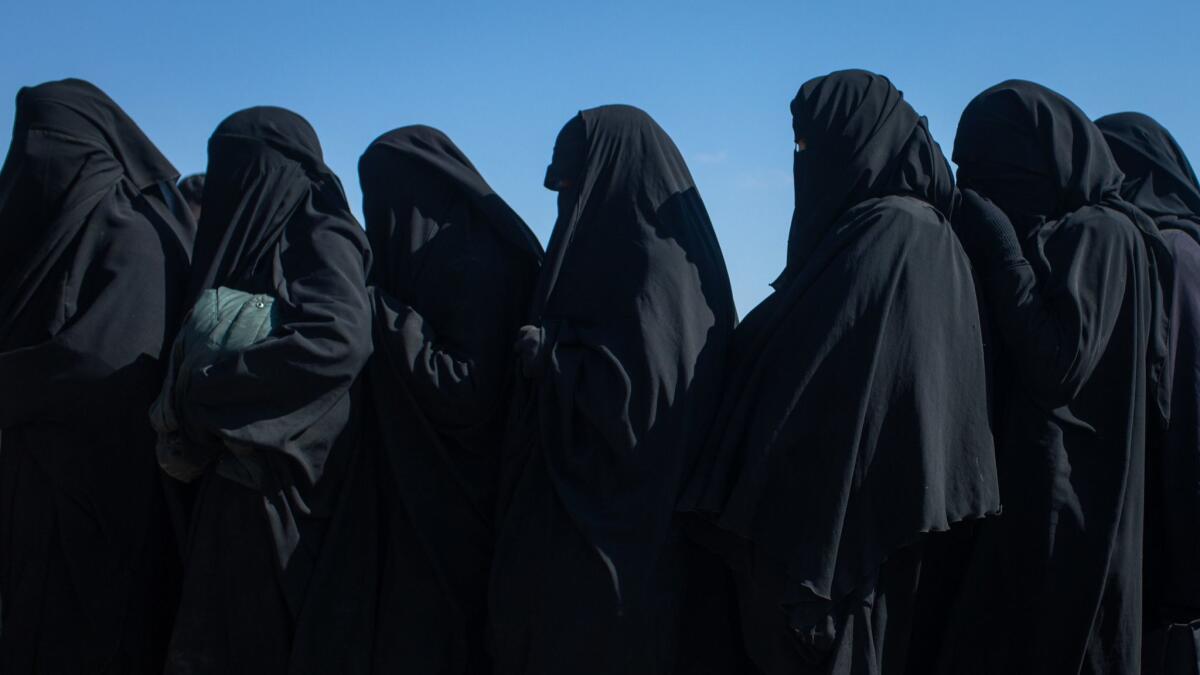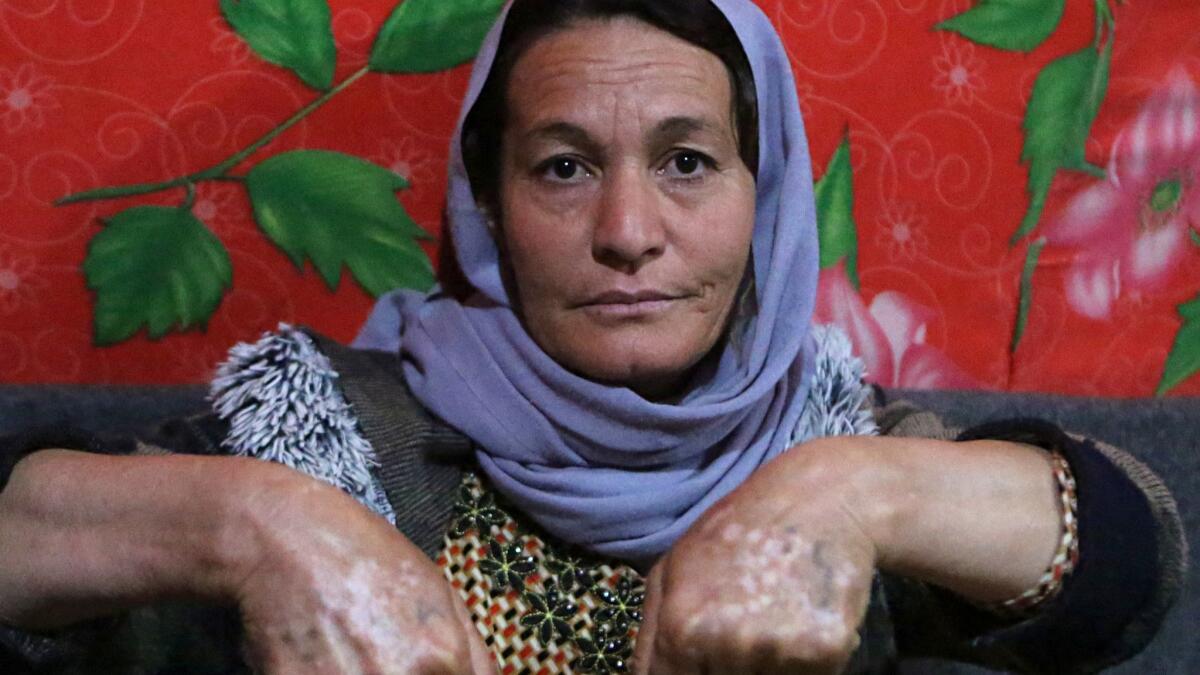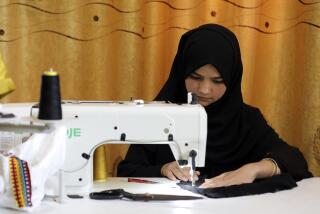Were the brides of Islamic State cloistered housewives or participants in atrocities?

Reporting from Beirut — Thousands of foreign-born women left their homes and lives to join Islamic State and marry its fighters. But now that the militant group’s so-called caliphate is reduced to crumbled masonry and scorched rebar, many of them want to return home.
Shamima Begum was a teenage schoolgirl in east London when she left home to join Islamic State; Hoda Muthana, an Alabama-born college student; Kimberly Gwen Polman, a 46-year-old single mom in Canada studying to be a children’s advocate. Now they’re held in a Kurdish-controlled prison in the hinterlands of eastern Syria, asking to be let back into their home countries.
The women branded “ISIS brides,” using initials for the militant group, have become a focal point of fierce debate for governments worldwide: What are states’ responsibilities toward these women?
A central question in that debate is, what exactly did the women do in the caliphate? Were they cloistered housewives largely ignorant of the group’s realities, or active participants in its genocidal acts?
As a wife and a mother they were participating directly in jihad because they’re creating the next generation of fighters.
— Charlie Winter, International Center for the Study of Radicalization

Women initially did not join combat
When Islamic State declared the establishment of its caliphate in 2014, it called upon all able-bodied Muslims to emigrate and engage in jihad, or struggle, to further its cause.
Initially, for women, that didn’t include combat, said Charlie Winter, a senior research fellow at the International Center for the Study of Radicalization at King’s College London.
“The role of the Muslim woman ideally was to be a wife and bear children,” he said in a phone interview, “and as a wife and a mother they were participating directly in jihad because they’re creating the next generation of fighters.”
While its militants were waging what Islamic State called “offensive jihad” — blitz campaigns that saw the group put a third of the territory of Iraq and Syria under its dominion — women were to be “bases of support” for husbands, fathers and sons, one wife explained.
Hayat Boumeddiene, the widow of Amedy Coulibaly, the Paris gunman who killed five people in two January 2015 attacks, offered advice for fighters’ wives during an interview in an Islamic State magazine.
“Be advisors to them. They should find comfort and peace with you,” she said in an article in the February 2015 issue of Dabiq. “Do not make things difficult for them. Facilitate all matters for them.”
Boumeddiene, who like her husband was born in France, is still at large and being sought by French authorities.
Women did claim more operational roles in suicide attacks outside Islamic State territories, said Devorah Margolin, a senior research analyst at the War Studies Department of King’s College London.
But most women who traveled to the caliphate intent on reaching the battlefield were unable to do so.
That changed to a degree as the group began to lose territory and many of its fighters were killed. It began to wage “defensive jihad.”
“By 2017 and 2018 they were proactively calling for women to engage in combat as well,” said Winter.
But there is little evidence women did so in large numbers.
Winter said there had been rumors of women given explosives and weapons training, but Islamic State never confirmed these reports.
There had been predictions women would increasingly take part in suicide bombings, since they generally have an easier time passing through checkpoints and their faces can remain hidden under their garments.
There was also precedence for their deployment: Abu Musab Zarqawi, the spiritual godfather of Islamic State, dispatched Sajida Rishawi with a suicide vest to the Hotel Radisson in the Jordanian capital of Amman in 2005. She failed to detonate her bomb but was caught by authorities after her husband’s device killed 38 people.
Some carried guns in the religious police force
Islamic State’s religious police, known as the Hisbah, roamed its territory to ensure residents were complying with the caliphate’s harsh edicts. People found in violation faced imprisonment, whipping and amputation. An all-female police force known as the Khansaa Brigade was an integral part of the Hisbah.
“We saw women in the Hisbah. They were all armed,” said Saad Ubaidi, who owns a beauty salon with his wife in Mosul, Iraq.
“Iraqi women had guns, but the foreigners carried ghadaraat,” said Ubaidi, using the slang term for Uzi machine guns.

Women played a vital part in the propaganda war
Women may not have fought on the battlefield, but they helped Islamic State spread its message.
“They were very much part of the propaganda machine of this state-building process,” said Margolin, who is writing a report on women’s roles in violent Islamist groups for George Washington University’s Program on Extremism.
Women were some of Islamic State’s most active recruiters online, she said.
Blogs and social media accounts ostensibly held by foreign-born female adherents advertised their lives as if they were in an Islamist utopia. They encouraged others to do hijrah, emigrate to the caliphate.
Some would provide a guide on how to avoid being identified as someone traveling to Syria to join Islamic State. Others would suggest what to pack for life in the caliphate (makeup and Islamic clothing, according to one blogger), or offer quotidian details on how the group assigned housing to fighters and women.
Others would cheer for the group’s barbarism and gruesome tactics.
Muthana, the Alabama-born student and daughter of a Yemeni diplomat who joined Islamic State in 2014, exhorted Americans to follow her lead.
“Soooo many Aussies and Brits here,” she tweeted from her now-suspended account. “But where are the Americans, wake up u cowards.”
She encouraged those who couldn’t travel to Islamic State territory to conduct terrorist attacks in the U.S.
“Veterans, Patriot, Memorial etc Day parades..go on drive by’s + spill all of their blood or rent a big truck n drive all over them. Kill them,” she tweeted.

Women took part in the enslavement of Yazidis
In August 2014, the extremists surrounded Mt. Sinjar in northwestern Iraq. They began to hunt the Yazidis, an ancient religious minority long persecuted for their beliefs, which include elements of Christianity and Judaism. Islamic State viewed them as devil-worshipers.
Thousands of Yazidi men were slaughtered; women and girls were kidnapped and driven away to be sold in markets or given as gifts. In their enslavement, the women and girls would be servants to the household’s wife and raped by the husband.
One wife of an Islamic State member with a Yazidi enslaved in her household defended the practice in an issue of Dabiq. Her article was entitled “Slave-girls or Prostitutes?”
The woman, who called herself Umm Sumayyah al Muhajirah, cited religious texts and the works of scholars to construct an argument for taking Yazidi women as concubines. And she dismissed reports of abuse, attributing them to “devious and wicked slave girls” who “made up lies and wrote false stories.”
And whereas sex with a Yazidi slave is permissible, she adds, prostitutes in the West “openly commit sin.”
“Leave us alone with your burping,” she wrote of people judging the slave practice.
Pinning down what each person did will be difficult

Investigators looking for clues to the individual actions of each woman, away from social media, will have a difficult time gathering evidence admissible in a court of law.
“In the U.S., we’ve had 16 people who returned that we know of — 13 have been prosecuted in federal courts, so there’s a system to do it,” said Seamus Hughes, deputy director of the Program on Extremism at George Washington University.
But most of those were people who admitted their actions, he added. For those who don’t, investigators using Islamic State documents, for example, have to have a rock-solid chain of evidence, which is difficult to establish in the chaotic environment of a war zone.
Witnesses, often intelligence or security personnel, are often reluctant to testify in open court, and identifying women dressed in three-layer niqabs, the de rigueur face covering, will be unreliable.
Even the social media presence these women maintained is being lost. Blogging sites like Tumblr or Wordpress, and messaging platforms such as Telegram, have aggressively shut down the accounts of Islamic State-affiliated users.
In any case, said Margolin, the women probably weren’t lying when they said they had been mostly concerned with family matters, but that didn’t absolve them of responsibility.
“Yes, they were wives and mothers, but what that means isn’t like what we mean when we think of a housewife,” said Margolin.
As the bearers of the group’s ideology for the next generation of fighters, she said, they were pursuing a higher objective.
“They represented,” said Margolin, “the future and permanence of Islamic State.”
More to Read
Sign up for Essential California
The most important California stories and recommendations in your inbox every morning.
You may occasionally receive promotional content from the Los Angeles Times.











